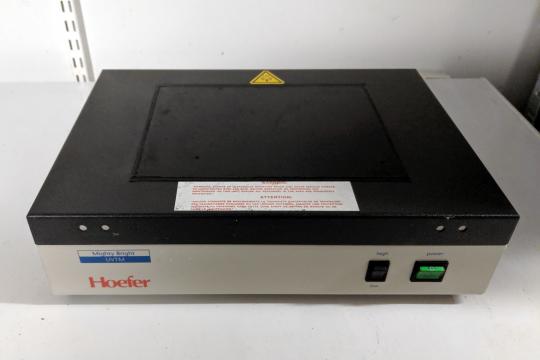Protection from UV light

First, some definitions
UV-C (100/200-280/290nm, short-wave, hard UV)
UV-B (290-315nm, medium-wave, intermediate UV)
UV-A (315-400nm, long-wave UV, soft UV, "black light")
Especially for UV-C, different wave-lengths cut-offs are occasionally used to define the borders between the different UV types. Some exclude the wavelengths below 200 nm from UV-C and refer to them with the term "vacuum UV (VUV)". Others subdevide the UV-C spectrum and refer to the wavelengths between 10 and 200 nm as "UV-C-VUV"). "Extreme UV (EUV)" refers to wave lengths between 10-121 nm and at the short end of this range, radiation is considered to be ionizing (similar to X-rays). However, I do not know of any clear wavelength border that is used to define a separation between ionizing and non-ionizing radiation.
Molecular biology
Most UV tables for molecular biology are used to detect ethidium bromid-stained DNA in agarose gels. They use a wavelength around 300nm (mostly 302nm), but some have a longer wavelength option (e.g. the Alpha Innotech LM-26E can be operated at 302 or 365 nm). Rule of thumb is that the longer the wave length the less damage is done to the DNA (but the signal from DNA-intercalated ethedium bromide becomes also weaker). There are 254-nm UV lamps, but these are not suitable for DNA since they will mutate your DNA within seconds. This is not surprising since the absorption maximum of DNA itself is at 260 nm and meaning that the maximum amount of radiation is absorbed by the DNA. Hence the 302 is a compromise between sensitivity and DNA-damage.
Working with a UV-table is not without danger and I would assume that there is more danger from UV than from the ethidium bromide stain, which some people (scientists!) for one or the other irrational reason are too much afraid of (https://bitesizebio.com/95/ethidium-bromide-a-reality-check/, http://rrresearch.fieldofscience.com/2006/10/heresy-about-ethidium-bromi..., https://blogs.sciencemag.org/pipeline/archives/2016/04/18/the-myth-of-et...). I have seen "sunburn" in one of my colleagues from too long exposure to UV light from UV-tables. The face mask protects your face, but you can still burn your arms or your décolletage.
UV-transmissive and UV-opaque materials
There is no way of knowning from the (visible) light transparency of a material how efficiently the material absorps UV light. Regular acrylic glass ("Plexiglas") is transparent to higher wavelength UV radiation (also called UV-A, 315-400 nm) and is therefore not suitable for protecting the eyes (https://www.gsoptics.com/transmission-curves/). Acrylic glass can be rendered UV-opaque by adding UV-absorbing additives. UV-filtering acrylic glass ("museum grade acrylic") comes in different qualities. If the UV wave length is below ~375nm, any UV-filtering grade acrylic will do. UF-4 acrylic glass protects the least: 80% of 400nm-UV is passed through a 2mm sheet. UF-3 protects better and UF-5 absorps almost all of the very near-visible light UV (>390nm).
Polycarbonate (PC) is your friend
However, when you need protection from UV, polycarbonate is your friend. 3 mm thick polycarbonate is virtually completely opaque to UV from most UV sources used for molecular biology up to 400 nm. Therefore, UV-protecting face masks and sun glasses are made mostly from polycarbonate.
2 mm, which is a bit thicker than the typical thickness of polycarbonate sunglasses, is mostly sufficient but the less efficient absorption compared to thicker polycarbonate matters only for UV above ~385nm (hence, good sun-glasses protect your eyes from molecular biology UV lamps, but your face skin still gets exposed). In fact, 2 mm thick polycarbonate sunglasses have less than 2 mm polycarbonate since they have on both sides of the polycarbonate a non-scratch non-UV-absorbing coating, because polycarbonate is very soft and gets scratched very easily. Unfortunately polycarbonate plastics are difficult to recognize as their number is "7" on the resin identification code (RIC) list, which is the mixed bag of "Other".
Interpreting producers' data
When you check the data sheets for the optical properties of transparent materials, you soon realize that they are difficult to interpret. You soon notice that the approach of producers' web sites is less scientific, but more advertising. They talk about UV-transmission in %, but do nowhere mention the thickness of the material, which is one of the most important aspects of absorption/transmission (https://en.wikipedia.org/wiki/Beer%E2%80%93Lambert_law). I strongly suspect that they use a 2 mm lightpath (thickness), the other possibility being 1 cm (which is the other "standard" length). If you have any insider knowledge, please let me know!



